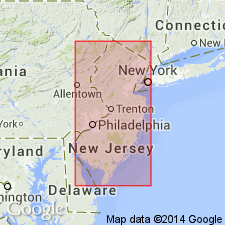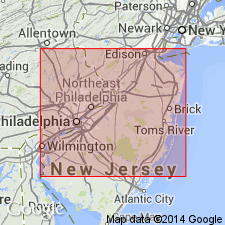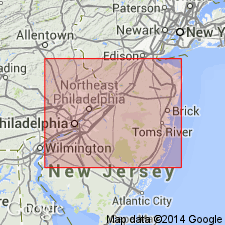
- Usage in publication:
-
- Shrewsbury member
- Modifications:
-
- First used
- AAPG geologic province:
-
- Atlantic Coast basin
Summary:
Upper Cretaceous Red Bank formation divided into Shrewsbury and Sandy Hook members.
Source: GNU records (USGS DDS-6; Reston GNULEX).

- Usage in publication:
-
- Shrewsbury Member
- Modifications:
-
- Named
- Dominant lithology:
-
- Sand
- AAPG geologic province:
-
- Atlantic Coast basin
Summary:
Shrewsbury is upper member of Redbank [Red Bank] Formation. Consists fine- to medium-grained, micaceous, feldspathic quartz sand that becomes coarser-grained where it grades into overlying Tinton Formation. Overlies Sandy Hook Member. Thickness about 80 ft. Thins and disappears north of New Egypt area where it is replaced by New Egypt Formation.
Source: GNU records (USGS DDS-6; Reston GNULEX).

- Usage in publication:
-
- Shrewsbury Member
- Modifications:
-
- Overview
- AAPG geologic province:
-
- Atlantic Coast basin
Summary:
The Maastrichtian unconformity-bounded sequence in the NJ coastal plain, here informally termed the Navesink sequence, includes the Navesink Formation, the Sandy Hook and Shrewsbury Members of the Red Bank Formation, and the Tinton Formation and ranges in age from 69.3 to 65 Ma based on Sr-isotope age estimates. Sequence is assigned to the calcareous nannofossil Zones CC20/21 and CC22b. High sedimentation rates in the latest Maastrichtian of NJ suggest tectonic uplift and/or rapid progradation during deposition of the highstand systems tract. The unconformable contact with the Campanian Mount Laurel Formation of the underlying Marshalltown sequence is marked by a reworked zone of a pebbly, poorly sorted, glauconite-quartz sand. The Navesink Formation is the transgressive, basal, clayey glauconite sand in a coarsening-upward sedimentary sequence. It is interpreted to be a middle-shelf deposit with large beds of calcareous shells dispersed throughout. The overlying Sandy Hook Member of the Red Bank is a massive, dark-gray, micaceous, fossiliferous, clayey silt and fine sand that grades upward into the Shrewsbury Member, a burrowed, slightly glauconitic, medium to coarse quartz sand that is unfossiliferous because of leaching. The sequence changes dramatically to the southwest along the outcrop belt. The Shrewsbury Member pinches out near New Egypt; the Sandy Hook changes from clayey fine sand to glauconite sand and pinches out several mi to the west of New Egypt, and the Navesink Formation thins or is locally absent. The Tinton Formation, uppermost Maastrichtian unit in NJ, crops out in a northern belt extending from the Atlantic Highlands southwestward to Perrineville and reaches a maximum thickness of 11 m just west of its type section. The Tinton is an unconsolidated to well-indurated, clayey, feldspathic, glauconite-quartz sand. The sequence unconformably underlies the Hornerstown Formation, dated as either Maastrichtian and early Paleocene or entirely early Paleocene.
Source: GNU records (USGS DDS-6; Reston GNULEX).
For more information, please contact Nancy Stamm, Geologic Names Committee Secretary.
Asterisk (*) indicates published by U.S. Geological Survey authors.
"No current usage" (†) implies that a name has been abandoned or has fallen into disuse. Former usage and, if known, replacement name given in parentheses ( ).
Slash (/) indicates name conflicts with nomenclatural guidelines (CSN, 1933; ACSN, 1961, 1970; NACSN, 1983, 2005, 2021). May be explained within brackets ([ ]).

